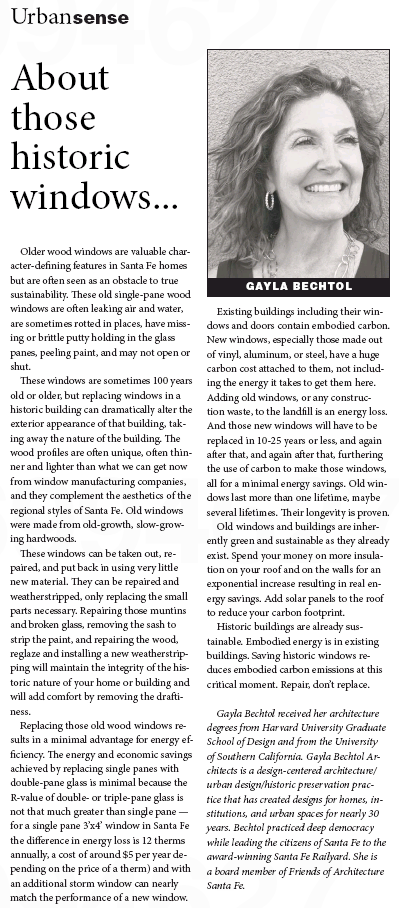In the October edition of The Santa Fe New Mexican’s Home Magazine, I talk about the benefits and value of repairing older wood windows vs. replacing them with new windows, in my column Urban Sense.
Read the Article:
Older wood windows are valuable character-defining features in Santa Fe homes but are often seen as an obstacle to true sustainability. These old single-pane wood windows are often leaking air and water, are sometimes rotted in places, have missing or brittle putty holding in the glass panes, peeling paint, and may not open or shut.
These windows are sometimes 100 years old or older, but replacing windows in a historic building can dramatically alter the exterior appearance of that building, taking away the nature of the building. The wood profiles are often unique, often thinner and lighter than what we can get now from window manufacturing companies, and they complement the aesthetics of the regional styles of Santa Fe. Old windows were made from old-growth, slow-growing hardwoods.
These windows can be taken out, repaired, and put back in using very little new material. They can be repaired and weatherstripped, only replacing the small parts necessary. Repairing those muntins and broken glass, removing the sash to strip the paint, and repairing the wood, reglaze and installing a new weatherstripping will maintain the integrity of the historic nature of your home or building and will add comfort by removing the draftiness.
Replacing those old wood windows results in a minimal advantage for energy efficiency. The energy and economic savings achieved by replacing single panes with double-pane glass is minimal because the R-value of double- or triple-pane glass is not that much greater than single pane — for a single pane 3’x4’ window in Santa Fe the difference in energy loss is 12 therms annually, a cost of around $5 per year depending on the price of a therm) and with an additional storm window can nearly match the performance of a new window.
Existing buildings including their windows and doors contain embodied carbon. New windows, especially those made out of vinyl, aluminum, or steel, have a huge carbon cost attached to them, not including the energy it takes to get them here. Adding old windows, or any construction waste, to the landfill is an energy loss. And those new windows will have to be replaced in 10-25 years or less, and again after that, and again after that, furthering the use of carbon to make those windows, all for a minimal energy savings. Old windows last more than one lifetime, maybe several lifetimes. Their longevity is proven.
Old windows and buildings are inherently green and sustainable as they already exist. Spend your money on more insulation on your roof and on the walls for an exponential increase resulting in real energy savings. Add solar panels to the roof to reduce your carbon footprint.
Historic buildings are already sustainable. Embodied energy is in existing buildings. Saving historic windows reduces embodied carbon emissions at this critical moment. Repair, don’t replace.
Gayla Bechtol received her architecture degrees from Harvard University Graduate School of Design and from the University of Southern California. Gayla Bechtol Architects is a design-centered architecture/urban design/historic preservation practice that has created designs for homes, institutions, and urban spaces for nearly 30 years. Bechtol practiced deep democracy while leading the citizens of Santa Fe to the award-winning Santa Fe Railyard. She is a board member of Friends of Architecture Santa Fe.


